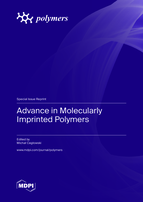Advance in Molecularly Imprinted Polymers
A special issue of Polymers (ISSN 2073-4360). This special issue belongs to the section "Polymer Applications".
Deadline for manuscript submissions: closed (5 January 2023) | Viewed by 29014
Special Issue Editor
Interests: materiel characterization; nanomaterials sunthesis; molecularly imprinted polymers
Special Issues, Collections and Topics in MDPI journals
Special Issue Information
Molecularly imprinted polymers (MIPs) are undoubtedly an exciting class for polymers, as they possess antibody-like affinity toward particular molecules. Their very high selectivity is the fact that MIPs possess cavities that are complementary to the template molecules by size, shape, and presence of particular functional groups. The advantage of MIPs over natural antibodies is their high thermal and chemical stability, excellent reusability, and easy, low-cost synthesis. As a result, MIPs have been widely used as artificial receptors for separation purposes, as sensors, to promote catalysis, during drug development, and for screening. MIPs can be produced for various target molecules, which contrasts with the biological receptors where the target must match an available antibody.
This Special Issue invites original papers and reviews reporting on recent progress in MIPs chemistry, which, among others, include:
- Novel MIPs synthesis methods
- Examination of interactions formed by MIPs
- MIPs application in separation, drug delivery, catalysis, as sensors
- Novel MIPs applications
- Synthesis of new MIPs monomers
- Obtaining surface-imprinted materials
- Synthesis and application of imprinted hybrid materials
Dr. Michał Cegłowski
Guest Editor
Manuscript Submission Information
Manuscripts should be submitted online at www.mdpi.com by registering and logging in to this website. Once you are registered, click here to go to the submission form. Manuscripts can be submitted until the deadline. All submissions that pass pre-check are peer-reviewed. Accepted papers will be published continuously in the journal (as soon as accepted) and will be listed together on the special issue website. Research articles, review articles as well as short communications are invited. For planned papers, a title and short abstract (about 100 words) can be sent to the Editorial Office for announcement on this website.
Submitted manuscripts should not have been published previously, nor be under consideration for publication elsewhere (except conference proceedings papers). All manuscripts are thoroughly refereed through a single-blind peer-review process. A guide for authors and other relevant information for submission of manuscripts is available on the Instructions for Authors page. Polymers is an international peer-reviewed open access semimonthly journal published by MDPI.
Please visit the Instructions for Authors page before submitting a manuscript. The Article Processing Charge (APC) for publication in this open access journal is 2700 CHF (Swiss Francs). Submitted papers should be well formatted and use good English. Authors may use MDPI's English editing service prior to publication or during author revisions.
Keywords
- molecularly imprinted polymers
- molecular imprinting
- molecular recognition
- functional polymers
- functional monomers
- selective interactions
- separation techniques
- solid-phase extraction
- drug delivery
- sensing
- ion imprinting







